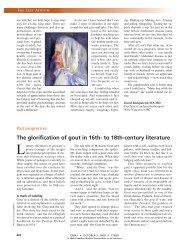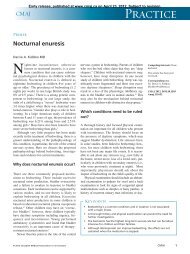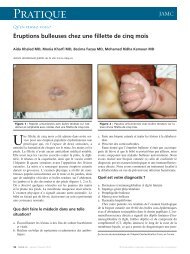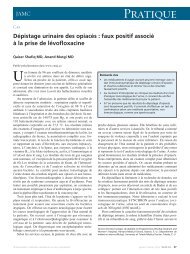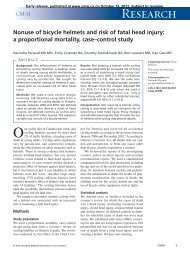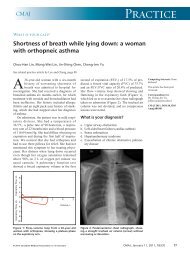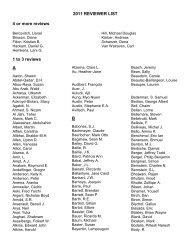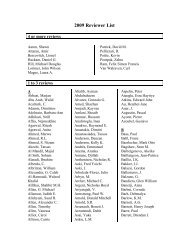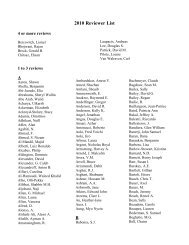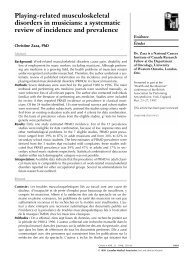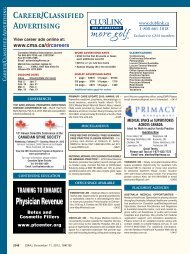Tips for teachers of evidence-based medicine: 1. Relative risk ...
Tips for teachers of evidence-based medicine: 1. Relative risk ...
Tips for teachers of evidence-based medicine: 1. Relative risk ...
You also want an ePaper? Increase the reach of your titles
YUMPU automatically turns print PDFs into web optimized ePapers that Google loves.
Barratt et al<br />
Appendix 2: Summary cards <strong>for</strong> 3 teaching tips on relative <strong>risk</strong> reduction, <strong>risk</strong> difference and number needed to treat<br />
This appendix has been designed so that it can be printed on a single sheet <strong>of</strong> 8 fi × 11 inch paper. The individual summary cards can then be cut<br />
out, if desired, <strong>for</strong> use during teaching sessions.<br />
Teaching tip 1: Understanding <strong>risk</strong> and <strong>risk</strong> reduction<br />
Scenario: Consider randomized trials <strong>of</strong> a therapy done on 2 populations, one with a high rate <strong>of</strong> a serious disease and the other with a<br />
lower rate. In each population, half the people are randomly assigned to receive a treatment <strong>for</strong> the disease.<br />
<strong>1.</strong> Draw 2 bars side by side to represent the results in the high-<strong>risk</strong> population:<br />
bar 1 is the event rate in the control group (40%), bar 2 is the event rate in the treatment group (30%).<br />
2. Ask the learners to describe the impact <strong>of</strong> treatment (<strong>risk</strong> difference 10%, relative <strong>risk</strong> reduction 25%).<br />
3. Repeat the process with bars 3 and 4 representing the results <strong>of</strong> the trial in the low-<strong>risk</strong> population: bar 3 is the event rate in the control<br />
group (10%), bar 4 is the event rate in the treatment group (7.5%), <strong>risk</strong> difference is 2.5%, and relative <strong>risk</strong> reduction is 25%.<br />
4. Learners discover the relation between the <strong>risk</strong> difference and the event rate in the control group.<br />
Summary points<br />
• Event rate is the percentage <strong>of</strong> people in a group experiencing an outcome event <strong>of</strong> interest.<br />
• Risk difference is the arithmetic difference in event rates achieved by therapy.<br />
• <strong>Relative</strong> <strong>risk</strong> reduction is the proportional decrease in event rates achieved by therapy.<br />
• <strong>Relative</strong> <strong>risk</strong> reduction is impressively larger than the <strong>risk</strong> difference when event rates are low.<br />
Teaching tip 2: Balancing benefits and adverse effects in individual patients<br />
Scenario: Consider 2 hypertensive patients (mean blood pressure 170/100 mm Hg); one patient (Pat) is asymptomatic, and the other<br />
(Dorothy) has a history <strong>of</strong> stroke. Both are being considered <strong>for</strong> a new antihypertensive, drug X, with relative <strong>risk</strong> reduction <strong>for</strong> stroke <strong>of</strong> 33%<br />
over 3 years. Drug X also increases the <strong>risk</strong> <strong>of</strong> severe gastric bleeding 3-fold over 3 years.<br />
<strong>1.</strong> a) Estimate Pat’s baseline <strong>risk</strong> <strong>of</strong> stroke as 1% per year or 3% over 3 years.<br />
b) Learners calculate Pat’s 3-year <strong>risk</strong> <strong>of</strong> stroke with drug X (2%).<br />
c) Learners calculate Pat’s 3-year <strong>risk</strong> difference <strong>for</strong> stroke (1%).<br />
2. a) Estimate Dorothy’s baseline <strong>risk</strong> <strong>of</strong> stroke as 10% per year or 30% over 3 years.<br />
b) Learners calculate Dorothy’s 3-year <strong>risk</strong> <strong>of</strong> stroke with drug X (20%).<br />
c) Learners calculate Dorothy’s 3-year <strong>risk</strong> difference <strong>for</strong> stroke (10%).<br />
3. a) Estimate Pat’s and Dorothy’s <strong>risk</strong> <strong>of</strong> severe gastric bleeding as 0.1% per year.<br />
b) Learners calculate the <strong>risk</strong> difference <strong>for</strong> severe gastric bleeding over 3 years <strong>for</strong> Pat and Dorothy (baseline <strong>risk</strong> = 0.3% over 3 years;<br />
with drug X = 0.9%; <strong>risk</strong> difference = 0.6%.)<br />
4. a) Learners compare the <strong>risk</strong> differences <strong>for</strong> Pat and Dorothy <strong>for</strong> both stroke and severe gastric bleeding.<br />
b) Learners discuss whether they would treat either <strong>of</strong> these 2 patients with drug X.<br />
Summary point<br />
• Trial data can be individualized by calculating and comparing <strong>risk</strong> differences <strong>for</strong> benefits and harms if a patient's <strong>risk</strong> <strong>of</strong> the relevant<br />
outcomes with and without treatment are known or can be estimated.<br />
Teaching tip 3: Calculating and using number needed to treat (NNT)<br />
Scenario: Consider 3 patients: a 60-year-old person with mild hypertension who is being treated with a diuretic to prevent stroke over 5 years; a<br />
60-year-old who had a myocardial infarction 1 month previously, has no congestive heart failure and is being treated with a β-blocker to prevent<br />
death over 2 years; and a 60-year-old with acute myocardial infarction treated with streptokinase to prevent death over 5 weeks.<br />
<strong>1.</strong> Learners guess the <strong>risk</strong> differences and NNTs <strong>for</strong> each treatment.<br />
2. Provide event rates in control and treatment groups, and calculate the <strong>risk</strong> differences (event rates <strong>for</strong> control group 2.9%, 9.8%, 12.0%<br />
respectively; event rates <strong>for</strong> treatment groups <strong>1.</strong>9%, 7.3%, 9.2% respectively; <strong>risk</strong> differences <strong>1.</strong>0%, 2.5%, 2.8% respectively).<br />
3. Explain how to calculate NNT from the <strong>risk</strong> difference (RD): NNT = 100/RD (NNTs 100, 40, 36 respectively)<br />
4. Compare learners’ guesses with the real data.<br />
5. Discuss threshold NNT.<br />
Summary points<br />
• NNT is a clinically useful measure <strong>of</strong> effectiveness.<br />
• NNT is easily calculated from <strong>risk</strong> difference.<br />
• Risk difference = control event rate - treatment event rate.<br />
• If the <strong>risk</strong> difference is expressed as a proportion, divide into 1; if expressed as a percentage, divide into 100.<br />
• Physicians <strong>of</strong>ten overestimate the effectiveness <strong>of</strong> treatments and underestimate the corresponding NNTs.<br />
Online-8 JAMC • 17 AOÛT 2004; 171 (4)



